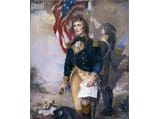
Military Engineer and National Leader plays a prominent role in the American Revolutionary War
Tadeusz KoÅ›ciuszko (1746 – 1817) was a member of the Polish nobility who decided on a career in the military. He completed studies at the military academy in Warsaw and was sent by King Poniatowski to Paris for further study in military and civil architecture, where he also studied the democratic ideals of John Locke and the ancient Greeks. Upon returning to Poland, he taught drawing and mathematics to the daughters of a general, Józef Sosnowski. Falling in love with one of the daughters, Ludwika, the two tried to elope but were unsuccessful. Facing the wrath of Ludwika’s father, KoÅ›ciuszko fled to France, where, in 1776, he was recruited by Silas Deane and Benjamin Franklin to fight for the American revolution against England.
Initially a volunteer, he was made a Colonel of Engineers and then Chief Engineer of the Continental Army. His talent with defensive fortifications played a crucial role in the American war effort. An unknown quantity initially, it did not take long for Kościuszko to distinguish himself. In quick succession, he constructed ingenious fortifications, most notably at Philadelphia, Saratoga, and West Point.
Posted to Fort Ticonderoga under Major General Gates to evaluate its defenses, he recommended constructing an artillery battery on Sugar Loaf, a high point overlooking the fort. The garrison commander, Brigadier General St. Clair, turned it down and this proved to be a tactical blunder. When British General Burgoyne arrived there, he did exactly what Kościuszko had warned of and had his engineers place their artillery on the hill. With the British in complete control of the high ground, the Americans realized their situation was hopeless and abandoned the fortress with hardly a shot fired.
Gates then tapped KoÅ›ciuszko to survey the country between the opposing armies, choose the most defensible position, and fortify it. Finding such a position near Saratoga, overlooking the Hudson at Bemis Heights, KoÅ›ciuszko laid out a strong array of defenses nearly impregnable from any direction. This frustrated the British attacks during the Battle of Saratoga and Gates accepted the surrender of Burgoyne’s force there on October 16, 1777, which became a turning point in the war. This is because it convinced Louis XVI and France to join the American cause against the British.
In 1778, KoÅ›ciuszko went to West Point and spent more than two years strengthening the fortifications and improving the stronghold’s defenses. It was his West Point plans that American General Benedict Arnold tried to pass to the British after he became a traitor. In 1780, serving under General Greene in North Carolina, he twice rescued the army from enemy advances by directing the crossing of the Yadkin and Dan rivers. In 1781 in South Carolina, KoÅ›ciuszko planned the Siege of Ninety-Six and organized the successful blockade of Charleston. At the end of the war he was given U.S. citizenship and was made a brigadier general in the U.S. Army.
In 1784, KoÅ›ciuszko returned to Poland hoping that the American Revolution could serve as a model for his own country. After Poland’s second partition by Russia and Prussia in 1793, he led an uprising against the two foreign powers in 1794. Assuming the title of commander in chief of Poland, he led the rebels in a number of valiant battles, which ultimately saw Russia and Prussia victorious. KoÅ›ciuszko then spent two years in captivity in Russia until Catherine the Great’s death in 1796. Her son, Tsar Paul I, freed him and KoÅ›ciuszko returned to the United States in 1797.
A close friend of Thomas Jefferson with whom he shared ideals of human rights, KoÅ›ciuszko wrote a will in 1798 dedicating his U.S. assets, $18,912 in back pay and 500 acres of land in Ohio, to the education and freedom of U.S. slaves. To the horror of his American friends, he freed Agrippa Hull, the slave he was given as an aide-de-camp during the war. Jefferson was executor of KoÅ›ciuszko’s will but did not carry out his wishes. KoÅ›ciuszko eventually returned to Europe and lived in Switzerland until his death in 1817. A year after Jefferson’s 1826 death, most of his slaves were sold at auction. As a side note, in the Thomas Jefferson Memorial in Washington D.C., the fur-trimmed leather coat he wears was a present from KoÅ›ciuszko. Thomas Jefferson said of KoÅ›ciuszko, “He is as pure a son of liberty as ever I have known.”
It turns out that famed English Romantic poets were also enamored with KoÅ›ciuszko. At the end of 1794, which is when the Poles failed in their uprising, Samuel Taylor Coleridge published his poem “Koskiusko”. In 1797, Henry Francis Cary wrote his “Ode to General Kosciuszko”. In 1815, Leigh Hunt wrote his poem “To Kosciusko” and in 1817, John Keats wrote his sonnet with the same title, “To Kosciusko”. In 1823, Lord Byron paid homage to KoÅ›ciuszko in his poem “The Age of Bronze”.
